Page 590 of 706
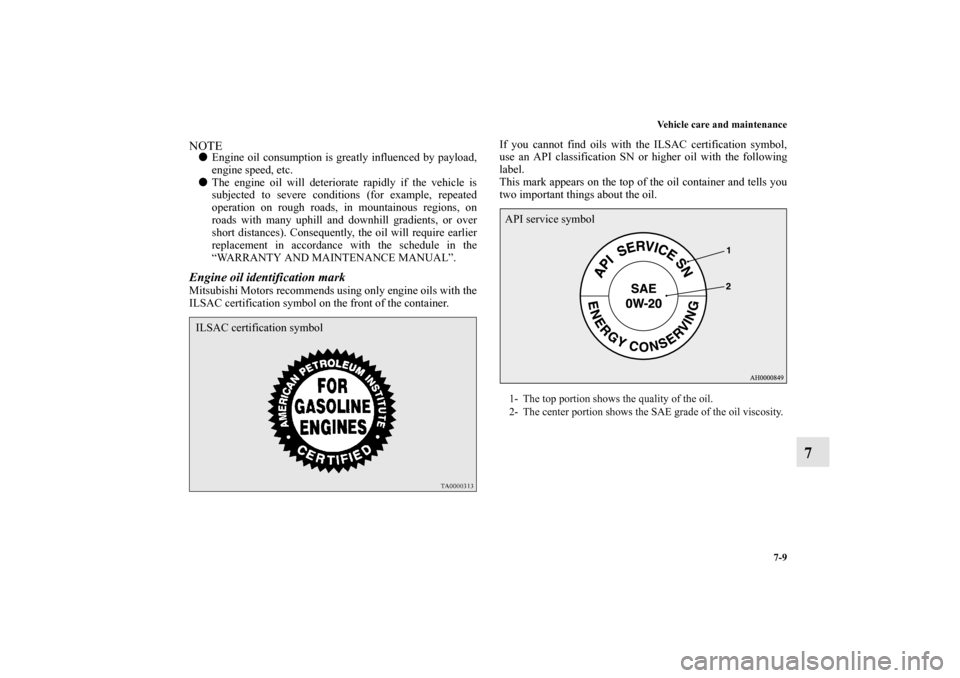
Vehicle care and maintenance
7-9
7
NOTE�Engine oil consumption is greatly influenced by payload,
engine speed, etc.
�The engine oil will deteriorate rapidly if the vehicle is
subjected to severe conditions (for example, repeated
operation on rough roads, in mountainous regions, on
roads with many uphill and downhill gradients, or over
short distances). Consequently, the oil will require earlier
replacement in accordance with the schedule in the
“WARRANTY AND MAINTENANCE MANUAL”.Engine oil identification markMitsubishi Motors recommends using only engine oils with the
ILSAC certification symbol on the front of the container.If you cannot find oils with the ILSAC certification symbol,
use an API classification SN or higher oil with the following
label.
This mark appears on the top of the oil container and tells you
two important things about the oil.ILSAC certification symbol
1- The top portion shows the quality of the oil.
2- The center portion shows the SAE grade of the oil viscosity.API service symbol
BK0151000US.book 9 ページ 2012年3月29日 木曜日 午後6時8分
Page 591 of 706
7-10 Vehicle care and maintenance
7
Recommended engine oil viscosity
N00955000083
Use engine oil with the proper thickness for the outdoor tem-
peratures where you will be driving.Except for vehicles equipped with turbochargerSAE 0W-20 engine oil is strongly recommended for optimum
fuel economy and cold starting.
If SAE 0W-20 is not available, the ILSAC certification oil of
other viscosity grades can be temporarily used.
Vehicles equipped with turbochargerNOTE�Select engine oil of the proper SAE viscosity number
according to the atmospheric temperature.
�SAE 0W-30 and 0W-40 engine oil are recommended to
use to improve engine startability on a very cold weather
condition.
BK0151000US.book 10 ページ 2012年3月29日 木曜日 午後6時8分
Page 592 of 706
Vehicle care and maintenance
7-11
7
To replace the oil filter
N00955100055
The oil filter should be replaced at the time or mileage speci-
fied in the “WARRANTY AND MAINTENANCE MAN-
UAL”.
Only use high quality replacement filters on this vehicle. The
manufacturer’s specifications for Genuine Mitsubishi oil filters
require that the filter can withstand a pressure of 256 psi
(1.8 MPa). A Genuine Mitsubishi oil filter is the best replace-
ment filter.
Follow the installation instructions printed on the filter.
Engine coolant
N00937800555
To check the coolant level The coolant reserve tank (A) lets you quickly see when you
need to add coolant. When the engine is cold, the level in the
reserve tank should be between the “FULL” and “LOW”
marks. The radiator usually stays full so there is no reason to
remove the radiator cap (B) except when you check the coolant
freeze point or replace the antifreeze coolant.
BK0151000US.book 11 ページ 2012年3月29日 木曜日 午後6時8分
Page 594 of 706
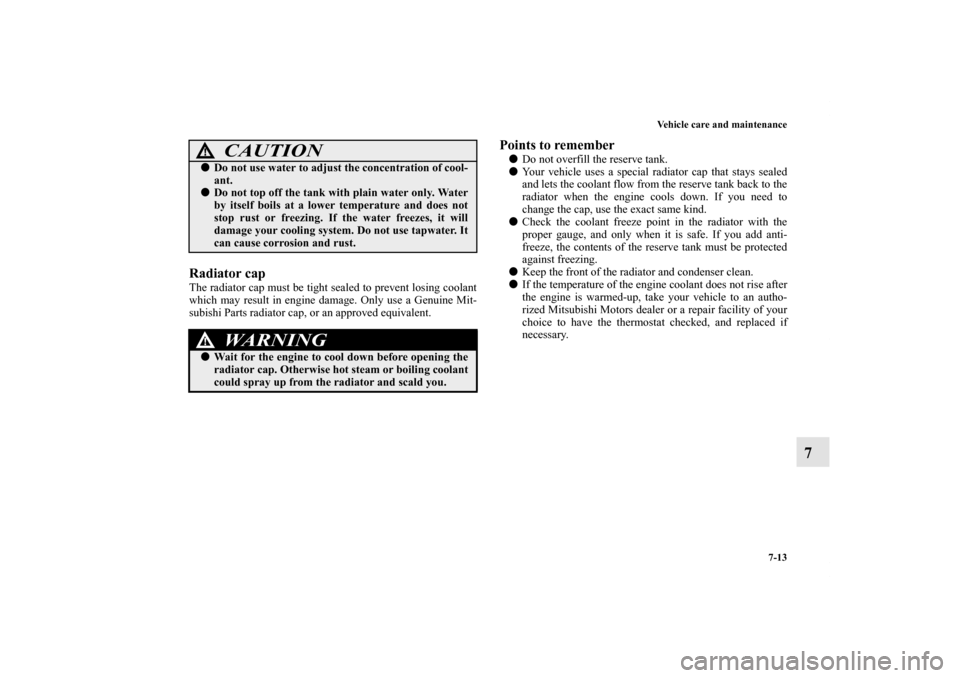
Vehicle care and maintenance
7-13
7
Radiator capThe radiator cap must be tight sealed to prevent losing coolant
which may result in engine damage. Only use a Genuine Mit-
subishi Parts radiator cap, or an approved equivalent.
Points to remember �Do not overfill the reserve tank.
�Your vehicle uses a special radiator cap that stays sealed
and lets the coolant flow from the reserve tank back to the
radiator when the engine cools down. If you need to
change the cap, use the exact same kind.
�Check the coolant freeze point in the radiator with the
proper gauge, and only when it is safe. If you add anti-
freeze, the contents of the reserve tank must be protected
against freezing.
�Keep the front of the radiator and condenser clean.
�If the temperature of the engine coolant does not rise after
the engine is warmed-up, take your vehicle to an autho-
rized Mitsubishi Motors dealer or a repair facility of your
choice to have the thermostat checked, and replaced if
necessary.
�Do not use water to adjust the concentration of cool-
ant.�Do not top off the tank with plain water only. Water
by itself boils at a lower temperature and does not
stop rust or freezing. If the water freezes, it will
damage your cooling system. Do not use tapwater. It
can cause corrosion and rust.
WA R N I N G
!�Wait for the engine to cool down before opening the
radiator cap. Otherwise hot steam or boiling coolant
could spray up from the radiator and scald you.
CAUTION
!
BK0151000US.book 13 ページ 2012年3月29日 木曜日 午後6時8分
Page 625 of 706
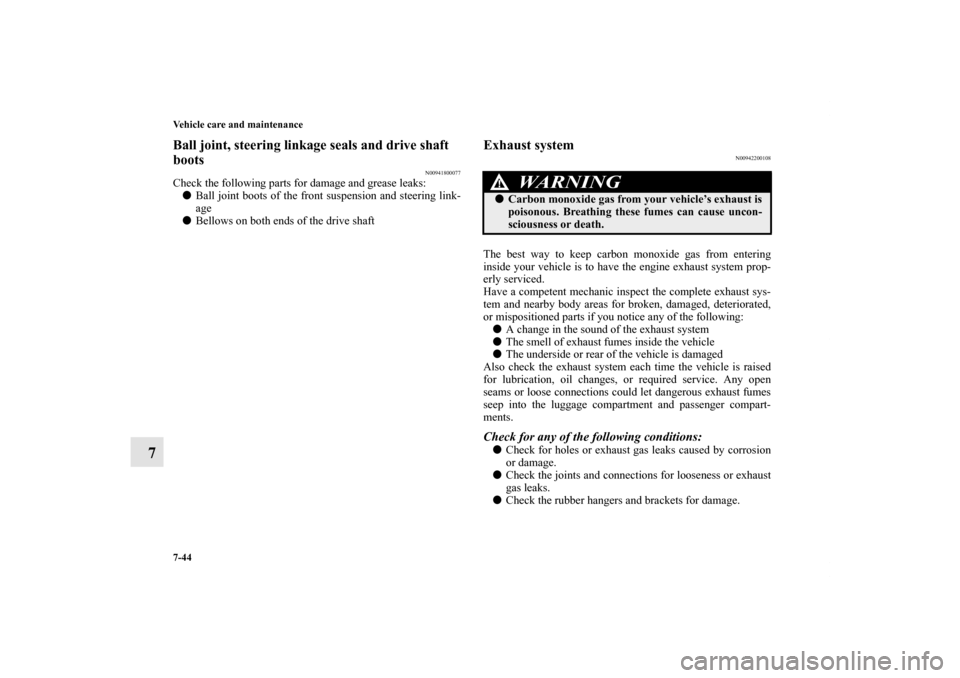
7-44 Vehicle care and maintenance
7
Ball joint, steering linkage seals and drive shaft
boots
N00941800077
Check the following parts for damage and grease leaks:
�Ball joint boots of the front suspension and steering link-
age
�Bellows on both ends of the drive shaft
Exhaust system
N00942200108
The best way to keep carbon monoxide gas from entering
inside your vehicle is to have the engine exhaust system prop-
erly serviced.
Have a competent mechanic inspect the complete exhaust sys-
tem and nearby body areas for broken, damaged, deteriorated,
or mispositioned parts if you notice any of the following:
�A change in the sound of the exhaust system
�The smell of exhaust fumes inside the vehicle
�The underside or rear of the vehicle is damaged
Also check the exhaust system each time the vehicle is raised
for lubrication, oil changes, or required service. Any open
seams or loose connections could let dangerous exhaust fumes
seep into the luggage compartment and passenger compart-
ments. Check for any of the following conditions: �Check for holes or exhaust gas leaks caused by corrosion
or damage.
�Check the joints and connections for looseness or exhaust
gas leaks.
�Check the rubber hangers and brackets for damage.
WA R N I N G
!�Carbon monoxide gas from your vehicle’s exhaust is
poisonous. Breathing these fumes can cause uncon-
sciousness or death.
BK0151000US.book 44 ページ 2012年3月29日 木曜日 午後6時8分
Page 626 of 706
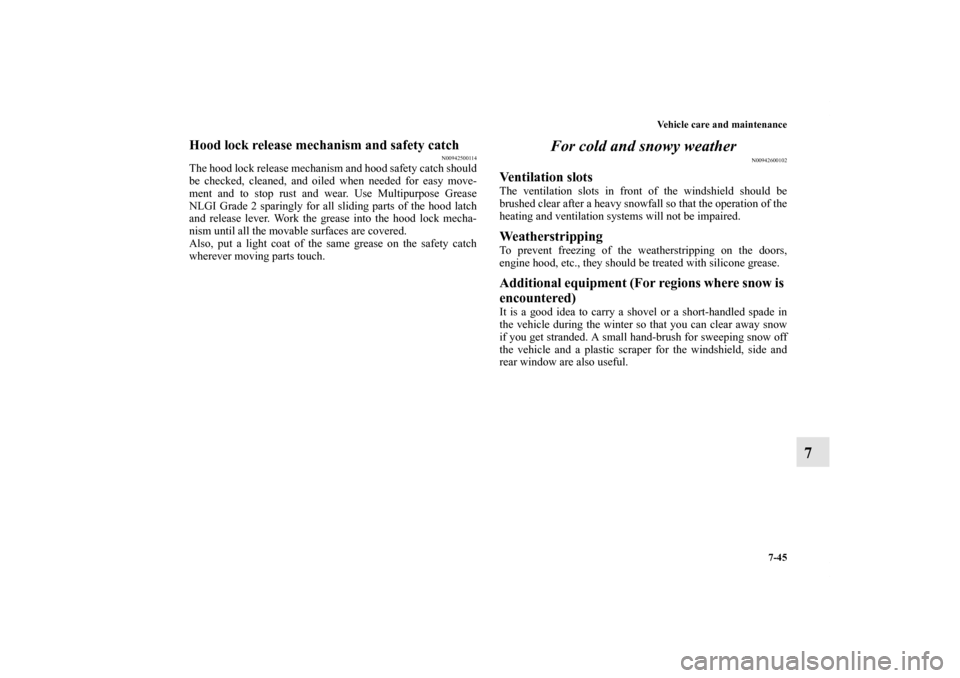
Vehicle care and maintenance
7-45
7
Hood lock release mechanism and safety catch
N00942500114
The hood lock release mechanism and hood safety catch should
be checked, cleaned, and oiled when needed for easy move-
ment and to stop rust and wear. Use Multipurpose Grease
NLGI Grade 2 sparingly for all sliding parts of the hood latch
and release lever. Work the grease into the hood lock mecha-
nism until all the movable surfaces are covered.
Also, put a light coat of the same grease on the safety catch
wherever moving parts touch.
For cold and snowy weather
N00942600102
Ventilation slotsThe ventilation slots in front of the windshield should be
brushed clear after a heavy snowfall so that the operation of the
heating and ventilation systems will not be impaired.WeatherstrippingTo prevent freezing of the weatherstripping on the doors,
engine hood, etc., they should be treated with silicone grease.Additional equipment (For regions where snow is
encountered)It is a good idea to carry a shovel or a short-handled spade in
the vehicle during the winter so that you can clear away snow
if you get stranded. A small hand-brush for sweeping snow off
the vehicle and a plastic scraper for the windshield, side and
rear window are also useful.
BK0151000US.book 45 ページ 2012年3月29日 木曜日 午後6時8分
Page 633 of 706
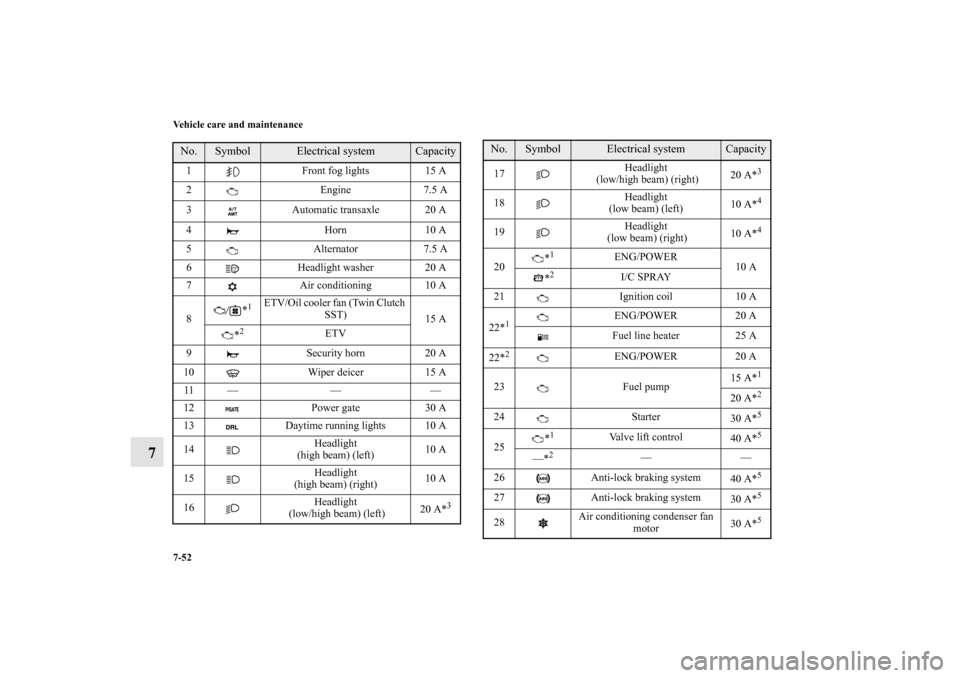
7-52 Vehicle care and maintenance
7
No.
Symbol
Electrical system
Capacity
1 Front fog lights 15 A
2 Engine 7.5 A
3 Automatic transaxle 20 A
4 Horn 10 A
5 Alternator 7.5 A
6 Headlight washer 20 A
7 Air conditioning 10 A
8*
1
ETV/Oil cooler fan (Twin Clutch
SST)
15 A
*
2
ETV
9 Security horn 20 A
10 Wiper deicer 15 A
11 — — —
12 Power gate 30 A
13 Daytime running lights 10 A
14Headlight
(high beam) (left)10 A
15Headlight
(high beam) (right)10 A
16Headlight
(low/high beam) (left)20 A*
3
17Headlight
(low/high beam) (right)20 A*
3
18Headlight
(low beam) (left)10 A*
4
19Headlight
(low beam) (right)10 A*
4
20*
1
ENG/POWER
10 A
*
2
I/C SPRAY
21 Ignition coil 10 A
22*
1
ENG/POWER 20 A
Fuel line heater 25 A
22*
2
ENG/POWER 20 A
23 Fuel pump15 A*
1
20 A*
2
24 Starter
30 A*
5
25*
1
Valve lift control
40 A*
5
—*
2
——
26 Anti-lock braking system
40 A*
5
27 Anti-lock braking system
30 A*
5
28Air conditioning condenser fan
motor30 A*
5
No.
Symbol
Electrical system
Capacity
BK0151000US.book 52 ページ 2012年3月29日 木曜日 午後6時8分
Page 675 of 706
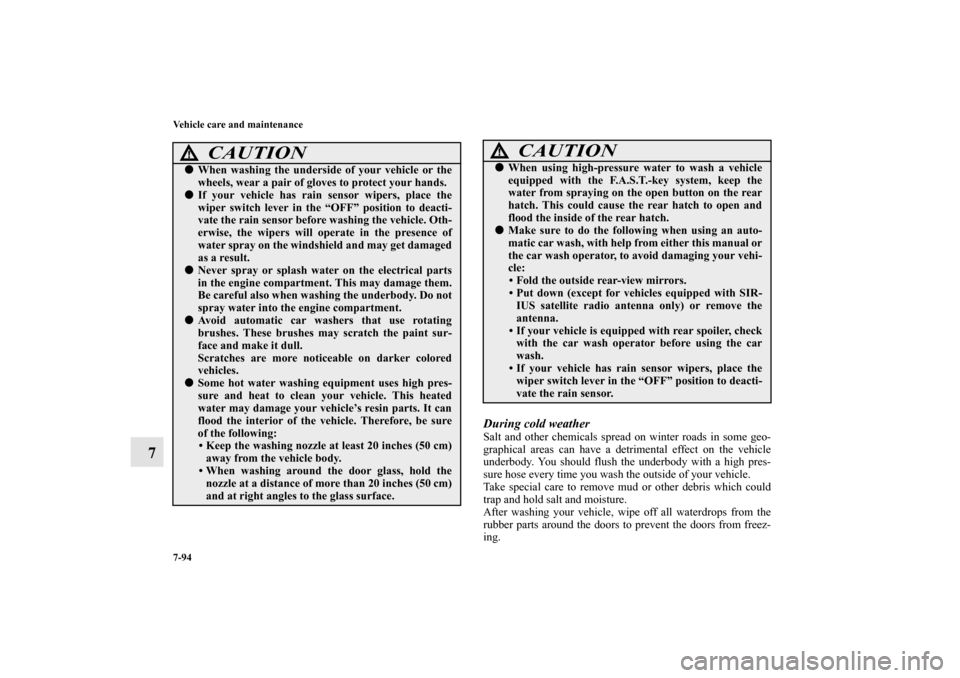
7-94 Vehicle care and maintenance
7
During cold weather Salt and other chemicals spread on winter roads in some geo-
graphical areas can have a detrimental effect on the vehicle
underbody. You should flush the underbody with a high pres-
sure hose every time you wash the outside of your vehicle.
Take special care to remove mud or other debris which could
trap and hold salt and moisture.
After washing your vehicle, wipe off all waterdrops from the
rubber parts around the doors to prevent the doors from freez-
ing.
CAUTION
!�When washing the underside of your vehicle or the
wheels, wear a pair of gloves to protect your hands.�If your vehicle has rain sensor wipers, place the
wiper switch lever in the “OFF” position to deacti-
vate the rain sensor before washing the vehicle. Oth-
erwise, the wipers will operate in the presence of
water spray on the windshield and may get damaged
as a result.�Never spray or splash water on the electrical parts
in the engine compartment. This may damage them.
Be careful also when washing the underbody. Do not
spray water into the engine compartment.�Avoid automatic car washers that use rotating
brushes. These brushes may scratch the paint sur-
face and make it dull.
Scratches are more noticeable on darker colored
vehicles.�Some hot water washing equipment uses high pres-
sure and heat to clean your vehicle. This heated
water may damage your vehicle’s resin parts. It can
flood the interior of the vehicle. Therefore, be sure
of the following:
• Keep the washing nozzle at least 20 inches (50 cm)
away from the vehicle body.
• When washing around the door glass, hold the
nozzle at a distance of more than 20 inches (50 cm)
and at right angles to the glass surface.
�When using high-pressure water to wash a vehicle
equipped with the F.A.S.T.-key system, keep the
water from spraying on the open button on the rear
hatch. This could cause the rear hatch to open and
flood the inside of the rear hatch. �Make sure to do the following when using an auto-
matic car wash, with help from either this manual or
the car wash operator, to avoid damaging your vehi-
cle:
• Fold the outside rear-view mirrors.
• Put down (except for vehicles equipped with SIR-
IUS satellite radio antenna only) or remove the
antenna.
• If your vehicle is equipped with rear spoiler, check
with the car wash operator before using the car
wash.
• If your vehicle has rain sensor wipers, place the
wiper switch lever in the “OFF” position to deacti-
vate the rain sensor.CAUTION
!
BK0151000US.book 94 ページ 2012年3月29日 木曜日 午後6時8分